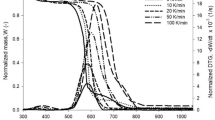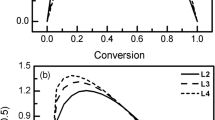Abstract
Isothermal decomposition process of commercial Creosote was analyzed by thermogravimetric technique in a nitrogen atmosphere, at four different operating temperatures (T = 230, 250, 270, and 290 °C). It was found that the two-parameter autocatalytic Šesták–Berggren kinetic model best describes the investigated process. It was established that the applied logistic function can successfully perform a given kinetic predictions of investigated process, at all operating temperatures. The experimental density distribution function of the apparent activation energy values was evaluated. Based of the characteristic shape of distribution curve, it was concluded that the isothermal pyrolysis of commercial Creosote represent a complex process, which probably includes primary and secondary (autocatalytic) pyrolysis reactions, together with various decomposition reactions and radicals recombination pathways.







Similar content being viewed by others
References
Erickson GL. Recent developments on Creosote. Proc Am Wood-Preservers’ Assoc. 1960;56:138–43.
Toxicological profile for wood Creosote, coal-tar Creosote, Coal-tar, Coal-tar pitch, and Coal-tar pitch volatiles, U.S. Department of Health and Human Services, Public Health Service, Agency for Toxic Substances and Disease Registry, Atlanta, Georgia 30333, USA, 2002, pp. 216–232.
Alscher A, Lohnert G. Creosote. New aspects of technical developments and environmental requirements. In: Record of the 1985 annual convention of the British Wood Preserving Association, Cambridge, 25–28 June, London, British Wood Preserving Association, 1985, pp. 55–63.
Melber C, Kielhorn CJ, Mangelsdorf I. Coal-tar Creosote. Concise International Chemical Assessment (CICA) Document 62, Published under the joint sponsorship of the United Nations Environment Programme, the International Labour Organization, and the World Health Organization, and produced within the framework of the Inter-Organization Programme for the Sound Management of Chemicals, World Health Organization, Geneva, 2004, pp. 4–5.
Xiao Y, Simonsen J, Morrell JJ. Laboratory simulation of leaching from creosote treated wood in aquatic exposures. International Research Group on Wood Preservation, 31st Annual Meeting, Kona, Hawaii, 14–19 May, 2000, pp. 5–8.
Kohler M, Kunniger T, Schmid P, Gujer E, Crockett R, Woifensberger M. Inventory and emission factors of creosote, polycyclic aromatic hydrocarbons (PAH), and phenols from railroad ties treated with Creosote. Environ Sci Technol. 2000;34:4766–72.
Drisko RW, Hochman H. A chromatographic method for the separation of saturated hydrocarbons from Creosote. Corrosion. 1960;16:405–10.
Drisko RW. Creosote analysis by the TEG-F, chromatographic, and spectrophotometric methods. For Prod J. 1964;14:119–23.
Roche JN. Coal-tar Creosote: its composition and how it functions as a wood preservative. For Prod J. 1952;2:75–9.
Petrowitz HJ, Becker G. Chemical composition of creosote in beech and pine sleepers after various service times. Mater Prufung. 1964;6:461–70.
Hedrick SE, Bennett RM, Rials TG, Kelley SS. Correlation of near-Infrared spectroscopy measurements with the properties of treated wood. J Mater Civil Eng. 2007;19:279–85.
Bogan BL, Lamar RT. One-electron oxidation in the degradation of creosote polycyclic aromatic hydrocarbons by Phanerochaete chrysosporium. Appl Environ Microbiol. 1995;61:2631–5.
Rasmussen G, Fremmersvik G, Olsen RA. Treatment of creosote-contaminated groundwater in a peat/sand permeable barrier—a column study. J Haz Mater. 2002;93:285–306.
Moret S, Purcaro G, Conte LS. Polycyclic aromatic hydrocarbon (PAH) content of soil and olives collected in areas contaminated with creosote released from old railway ties. Sci Total Environ. 2007;386:1–8.
Lin HC, Ohuchi T, Murase Y, Shiah TC, Gu LT, Lee MJ, Wu YD. Application of TGA and EDX analysis to evaluate the process of preservative-treated woods. J Fac Agr Kyushu Univ. 2006;51:337–44.
Lin HC, Murase Y. Estimation of the thermal decomposition and analysis of evolved species and char of wood preservatives using thermogravimetric analysis combined with spectrometric techniques. J Fac Agr Kyushu Univ. 2007;52:371–80.
Marutzky R. Entsorgung von mit Holzschutzmitteln behandelten Hölzern—Möglichkeiten und Probleme. Holz als Roh—und Werkstoff. 1990;48:19–24.
Miura K. A new and simple method to estimate f(E) and k 0(E) in the distributed activation energy model from three sets of experimental data. Energy Fuels. 1995;9:302–7.
Friedman HL. Kinetics of thermal degradation of char-forming plastics from thermogravimetry-application to a phenolic resin. J Polym Sci C. 1964;6:183–95.
Málek J. Kinetic analysis of crystallization processes in amorphous materials. Thermochim Acta. 2000;355:239–53.
Koga N, Málek J, Šesták J, Tanaka H. Data treatment in non-isothermal kinetics and diagnostic limits of phenomenological models. Netsu Sokutei. 1993;20:210–23.
Omrani A, Rostami AA, Ravari F. Advanced isoconversional and master plot analyses on solid-state degradation kinetics of a novel nanocomposite. J Therm Anal Calorim. 2013;111:677–83.
Ortega A, Macías M, Gotor FJ. Kinetics of the thermal decomposition of anhydrous cobalt nitrate by SCRT method. J Therm Anal Calorim. 2009;98:441–8.
Cai J, Liu R. Kinetic analysis of solid-state reactions: a general empirical kinetic model. Ind Eng Chem Res. 2009;48:3249–53.
Burnham AK, Braun RL. Global kinetic analysis of complex materials. Energy Fuels. 1999;13:1–22.
Šesták J. Science of heat and thermophysical studies: a generalized approach to thermal analysis. Amsterdam: Elsevier Science B.V; 2005. p. 276–340.
Cramer JS. The origins of logistic regression. Paper TI 2002-119/4, Tinbergen Institute Discussion Paper, Faculty of Economics and Econometrics, University of Amsterdam and Tinbergen Institute, Amsterdam 3645 Vinkeveen, The Netherlands, 2002, pp. 1–15.
Vyazovkin S, Burnham AK, Criado JM, Pérez-Maqueda LA, Popescu C, Sbirrazzuoli N. ICTAC Kinetics Committee recommendations for performing kinetic computations on thermal analysis data. Thermochim Acta. 2011;520:1–19.
Norinaga K, Deutschmann O. Detailed kinetic modeling of gas-phase reactions in the chemical vapor deposition of carbon from light hydrocarbons. Ind Eng Chem Res. 2007;46:3547–57.
Norinaga K, Deutschmann O, Saegusa N, Hayashi J. Analysis of pyrolysis products from light hydrocarbons and kinetic modeling for growth of polycyclic aromatic hydrocarbons with detailed chemistry. J Anal Appl Pyrol. 2009;86:148–60.
Britt PF, Buchanan AC, Owens CV Jr. Mechanistic investigation into the formation of polycyclic aromatic hydrocarbons from the pyrolysis of terpenes. Prepr Pap Am Chem Soc Div Fuel Chem. 2004;49:868–71.
Amzad Hossain M, Salehuddin SM. Identification of some carcinogenic polycyclic aromatic hydrocarbons in Bangladeshi vehicles exhaust tar by gas chromatography-mass spectrophotometer. Indo J Chem. 2008;8:353–5.
Kestens V, Anclair G, Drozdzewska K, Held A, Roebben G, Linsinger T. Thermodynamic property values of selected polycyclic aromatic hydrocarbons measured by differential scanning calorimetry. J Therm Anal Calorim. 2010;99:245–61.
Katritzky AR, Ramsden CA, Joule JA, Zhdankin VV. Handbook of heterocyclic chemistry. 3rd ed. Amsterdam: Elsevier Ltd.; 2010. p. 32–233.
Nelson PF, Smith IW, Tyler RJ, Mackie JC. Pyrolysis of coal at high temperatures. Energy Fuels. 1988;2:391–400.
Shanshai M, Abdullah HH. A study of the thermal C–C and C–H bond cleavage in the aromatic molecules: acenaphthene and acenaphthylene. Jordan J Chem. 2012;7:329–37.
Smith CM, Savage PE. Reactions of polycyclic alkylaromatics: structure and reactivity. AIChE J. 1991;37:1613–24.
Pakpahan EN, Isa MH, Kutty SRM, Malakahmad A. Effect of temperature on the formation and degradation of polycyclic aromatic hydrocarbons. International Conference on Emerging Technologies in Environmental Science and Engineering, October 26–28, Aligarh Mislim University, Aligarh, India, 2009, pp. 569–574.
Šesták J, Berggren G. Kinetics of the mechanism of solid-state reactions at increasing temperatures. Thermochim Acta. 1971;3:1–12.
Vlaev L, Georgieva V, Genieva S. Products and kinetics of non-isothermal decomposition of vanadium(IV) oxide compounds. J Therm Anal Calorim. 2007;88:805–12.
Roscoe JM, Thompson MJ. Thermal decomposition of methane: autocatalysis. Int J Chem Kinet. 1985;17:967–90.
Šesták J, Kozmidis-Petrović A, Živković Ž. Crystallization kinetics accountability and the correspondingly developed glass-forming criteria—A personal recollection at the forty years anniversaries. J Min Metall Sect B Metall. 2011;47:229–39.
Božić P. Fungi tar degradation—possible application for micro-scale slow pyrolysis rotary kiln. A Master’s thesis, The School for Renewable Energy Science in affiliation with University of Iceland & the University of Akureyri, Akureyri, February 2009, pp. 1–54.
Lomnicki S, Truong H, Dellinger B. Mechanisms of product formation from the pyrolytic thermal degradation of catechol. Chemosphere. 2008;73:629–33.
Acknowledgements
The authors would like to thank the Ministry of Science and Environmental Protection of Serbia, for financial support of this research under the Projects 172015 (Bojan Janković) and III43009 (Marija Janković).
Author information
Authors and Affiliations
Corresponding author
Rights and permissions
About this article
Cite this article
Janković, B.Ž., Janković, M.M. Thermal characterization and isothermal kinetic analysis of commercial Creosote decomposition process. J Therm Anal Calorim 115, 823–832 (2014). https://doi.org/10.1007/s10973-013-3322-x
Received:
Accepted:
Published:
Issue Date:
DOI: https://doi.org/10.1007/s10973-013-3322-x




